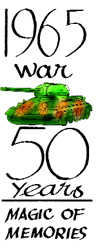I was posted at the Air Force Station in Ambala in 1961 after passing out. Ambala had four fighter squadrons. In 1962, during the Chinese aggression, the Air Force was not used for combat and only provided logistics support to the Army. It was in 1965 that the Air Force got a taste of conventional war.
Much before the actual operations began, we had moved to our operational locations The Air Traffic Services were moved to a wooden hut where one could barely squeeze in with the equipment neatly stacked, and supporting manpower in the open. Trenches were dug all around to jump in during air raids. A mobile control room on wheels concealed by the foliage of trees was made operational to control the air traffic.
Ambala town would observe a complete blackout at night and moving from the mess to the place of duty was hazardous.
On September 17, air raid sirens went out in full blast, making us jump into the trenches. We could hear an aircraft approaching but nothing was visible except the flashing lights of the anti-aircraft guns deployed around the airfield to protect the vital installations. The enemy B-57 approached the airfield, avoiding the firing of the guns, and dropped a load.
Reports revealed damage to buildings on the staff road and military hospital, but, fortunately, there was no loss of life. In the morning, ladies from the Red Cross visited us with eatables to rejuvenate our spirits.
On September 19, Ambala was again targeted. Flt Lt AJS Sandhu was carrying out the Continuous Air Patrol in a Gnat aircraft. The tranquility of the night was broken by air raid warnings alerting us about the enemy attack. We slipped into the trenches, warning Flt Lt Sandhu about the air raid warning. He climbed to a safe height to avoid the firing from the anti-aircraft guns.
I could heard the sound of an aircraft approaching the airfield from the west. The sound became louder as the aircraft came closer. The B-57 was visually spotted and Flt Lt Sandhu in order to be on the tail of the B-57 dived to a lower height, but spotting the target with naked eye was difficult in the darkness of the night.
The B-57 dropped a bomb which hit St Paul’s Church adjoining the airfield. The airfield was safe and so was the runway and hangar, which housed critical war equipment. It was sheer luck or the ineptitude of the B-57 pilot that the bomb did not explode on the tarmac.
The truth is that we had not learnt any lesson from the debacle at the hands of the Chinese. Our equipment remained obsolete, defending vital installations with .303s.
Ambala lacked electrical airfield lighting, night flying being dependent on kerosene lamps and manpower being deployed on both sides of the runway for lighting.
There was no surveillance radar which could have helped Flt Lt Sandhu in shooting down the B-57. But the spirits were high and the news of shooting of the first Sabre by Flt Lt Keelor spread like wildfire and there was no looking back in the air operations.
(The writer was on ATC duty during the night raids by Pakistani jets)










